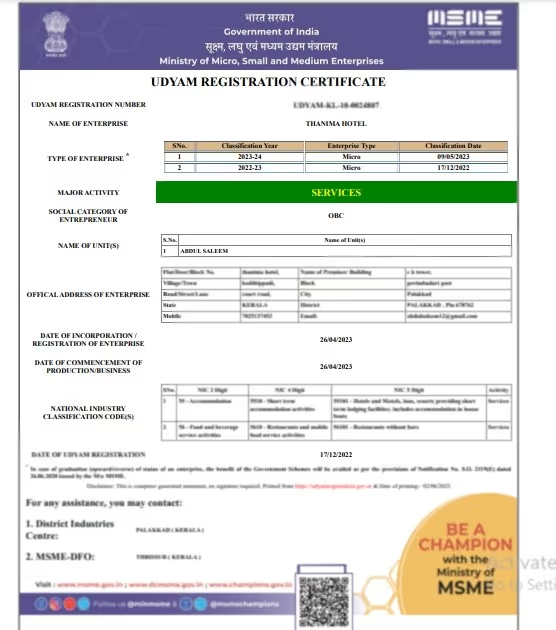The Articles of Association (AOA) define a company’s internal rules, governance, and management structure. It regulates the relationship between shareholders and the company, covering voting rights, dividends, and decision-making.
The AOA of a company must comply with the Companies Act, 2013 to ensure legal validity. It works alongside the Memorandum of Association to guide corporate operations. Understanding its role is essential for business owners, investors and stakeholders to ensure smooth management and legal compliance.
Table of Contents
Definition of Articles of Association Under Companies Act 2013
The Articles of Association, as per the section 2(5) of Companies Act, 2013, is a legally binding document that defines a company’s internal regulations and governance. It outlines the rights, duties, and responsibilities of shareholders, directors, and officers, ensuring structured management. Governed by Section 5 of the Companies Act, 2013, the AOA plays a crucial role in decision-making, dispute resolution, and compliance. A well-drafted AOA is essential for smooth company operations and legal clarity.
Objectives Outlined in Articles of Association
Section 5 of the Companies Act, 2013, defines the objective of AOA, outlining the internal rules that govern a company's management. Here are key objectives of Articles of Association:
- Serve as a regulatory framework, ensuring compliance with legal provisions.
- Define the company’s matters as prescribed under the relevant rules.
Additionally, companies have the flexibility to add provisions or make necessary alterations to their Articles of Association, provided they comply with legal requirements.
Purpose of Articles of Association
- Governance Framework: The AOA acts as a rulebook for a company’s management, outlining the rights and duties of directors, shareholders, and officers. It establishes decision-making processes and ensures smooth operations.
- Legal Requirement: As per the Companies Act, 2013, every company must have an AOA, which must be submitted to the Registrar of Companies (ROC) during incorporation. It serves as a legally binding document governing corporate affairs.
- Operational Clarity: The AOA defines clear procedures for shareholder meetings, director appointments, and financial management, ensuring all stakeholders understand company regulations and business operations.
- Shareholder Protection: It safeguards shareholder rights by establishing rules for voting, dividends, and dispute resolution. It also provides mechanisms to address conflicts and protect minority shareholders.
- Flexibility for Future Changes: The AOA allows modifications to accommodate business growth, structural changes, or legal amendments, provided the changes comply with the Companies Act, 2013.
By setting a lawful, transparent, and structured operational framework, the AOA ensures corporate stability and effective governance.
Scope and Extent of Articles of Association
The Articles of Association are legally binding on all current and future members, including heirs, successors, and legal representatives. They form a contractual agreement between the company and its members, outlining mutual rights, duties, and obligations. The Memorandum of Association sets the company's main objectives and key details, and it can only be changed at an Annual General Meeting (AGM) or Extraordinary General Meeting (EGM) with statutory approval.
The Registrar of Companies ensures that the company follows all legal regulations and operates within the law. Additionally, the shareholders have the right to appoint auditors who review financial records and ensure transparency in the company's finances.
Nature of Articles of Association
The Articles of Association is a legally binding document that governs a company’s internal management and operations. It sets the rules that directors, shareholders, and officers must follow. It also defines their rights, duties, and responsibilities within the company. By ensuring a structured and lawful operational framework, the AOA serves as the foundation of corporate governance, helping companies function efficiently and transparently.
Contents Encompassed Within the Articles of Association
- Share Capital: It defines shareholder rights, share certificates, and commission payments.
- Shareholder Rights: It specifies voting rights and dividend entitlements.
- Share Transactions: It covers share transfer, transmission, forfeiture, and surrender.
- Capital Alteration: It details processes for increasing, decreasing, or restructuring capital.
- Governance: It outlines director appointments, qualifications, powers, and board meetings.
- Financial Matters: It includes provisions on borrowing powers, accounts, audits, and reserves.
- Winding Up: It specifies procedures for closing the company and settling liabilities.
Components of AOA
- Name Clause: It states the official name of the company and specifies whether it is a public or private ltd. company.
- Registered Office Clause: It defines the company’s registered office address, which serves as the official location for all legal communication.
- Object Clause: It outlines the main objectives of the company and lists the business activities it is legally allowed to undertake.
- Liability Clause: It explains whether the members (shareholders) of the company have limited or unlimited financial liability.
- Share Capital Clause: It specifies the authorised share capital of the company, the different types of shares issued, and the rights and privileges of shareholders.
- Management Clause: It defines the powers, responsibilities, and duties of the directors, along with the procedures for their appointment, removal, and remuneration.
- General Meetings Clause: It sets the rules for conducting shareholder meetings, including notice periods, quorum requirements, voting rights, and decision-making procedures.
- Dividend Clause: It explains how and when the company distributes profits in the form of dividends to its shareholders.
- Winding-Up Clause: It describes the process for dissolving the company in case of liquidation, bankruptcy, or closure.
These components work together to create a structured framework that governs the company’s operations, financial management, and legal compliance.
Different Forms of Articles of Association
The Articles of Association must follow specific formats outlined in Schedule I, with forms categorised under Tables F, G, H, I, and J, depending on the type of company. Companies are required to adopt the form that aligns with their legal structure while registering their AOA.
Role of AOA in Company Registration
The Articles of Association play a crucial role in the company registration process. Along with the Memorandum of Association, it is a mandatory document required for incorporation under the Companies Act, 2013. The AOA defines the company’s internal governance, specifying rules for management, the rights and duties of members, and operational procedures. A well-structured AOA ensures legal compliance, protects stakeholders' interests, and provides clear guidelines for future operations. It also helps in conflict resolution by outlining decision-making processes and responsibilities, ensuring the smooth functioning of the company.
Difference Between Memorandum and Articles of Association
Conclusion
The Memorandum of Association and Articles of Association are essential documents for company formation and governance. While the MOA defines the company’s objectives and its relationship with external entities, the AOA outlines the internal rules for management, ensuring smooth operations. A well-drafted AOA, aligned with legal provisions, helps establish clear roles for directors, shareholders, and stakeholders, fostering transparency and efficiency. Together, these documents provide a strong legal foundation, guiding the company's growth and compliance with regulatory requirements, making them indispensable for long-term success.
Frequently Asked Questions
Private Limited Company
(Pvt. Ltd.)
- Service-based businesses
- Businesses looking to issue shares
- Businesses seeking investment through equity-based funding
Limited Liability Partnership
(LLP)
- Professional services
- Firms seeking any capital contribution from Partners
- Firms sharing resources with limited liability
One Person Company
(OPC)
- Freelancers, Small-scale businesses
- Businesses looking for minimal compliance
- Businesses looking for single-ownership
Private Limited Company
(Pvt. Ltd.)
- Service-based businesses
- Businesses looking to issue shares
- Businesses seeking investment through equity-based funding
One Person Company
(OPC)
- Freelancers, Small-scale businesses
- Businesses looking for minimal compliance
- Businesses looking for single-ownership
Private Limited Company
(Pvt. Ltd.)
- Service-based businesses
- Businesses looking to issue shares
- Businesses seeking investment through equity-based funding
Limited Liability Partnership
(LLP)
- Professional services
- Firms seeking any capital contribution from Partners
- Firms sharing resources with limited liability
Frequently Asked Questions
What are the conditions for the provisions of entrenchment in the AOA?
The provisions for entrenchment can be included in AOA either at the time of company formation or through an amendment. In both cases, the company must notify the ROC.
The inclusion of entrenchment provisions can be done:
- At the time of company formation by incorporating them in the initial AOA.
- Through an amendment with the approval of all company members.
- In a public limited company by passing a special resolution.
Can the AOA be altered?
Yes, the AOA can be altered at any time through a special resolution. The revised AOA must be filed with the Registrar of Companies to be legally valid.
Can the AOA go beyond the scope of the MOA?
No, the AOA cannot go beyond the scope of the MOA. Any provision in the AOA that exceeds the scope of the MOA is considered ultra vires (beyond legal authority) and is deemed invalid.
How do Articles of Association differ from Articles of Incorporation?
The Articles of Association govern a company’s internal management, outlining rules for operations, shareholder rights, and director responsibilities. In contrast, Articles of Incorporation (also known as a Certificate of Incorporation) are legal documents filed with the government to officially register a company.
Who creates Articles of Association?
The founders or promoters of a company draft the AOA at the time of company incorporation. It is then submitted to the Registrar of Companies along with the MOA for approval.
%20of%20a%20Company%20in%20India.webp)





.webp)












